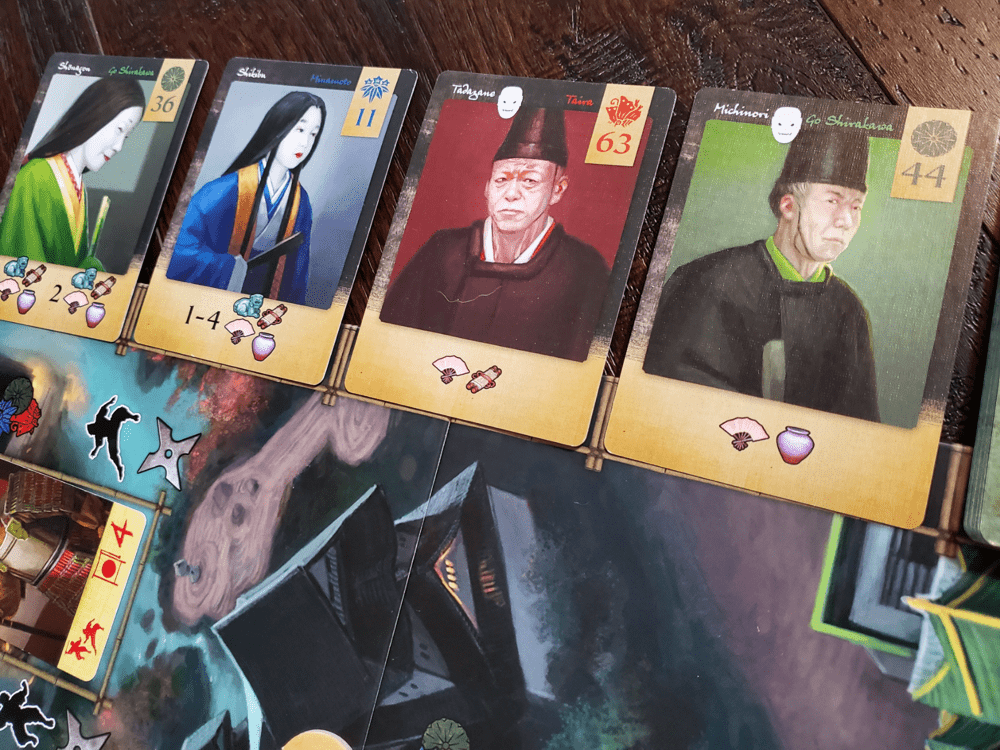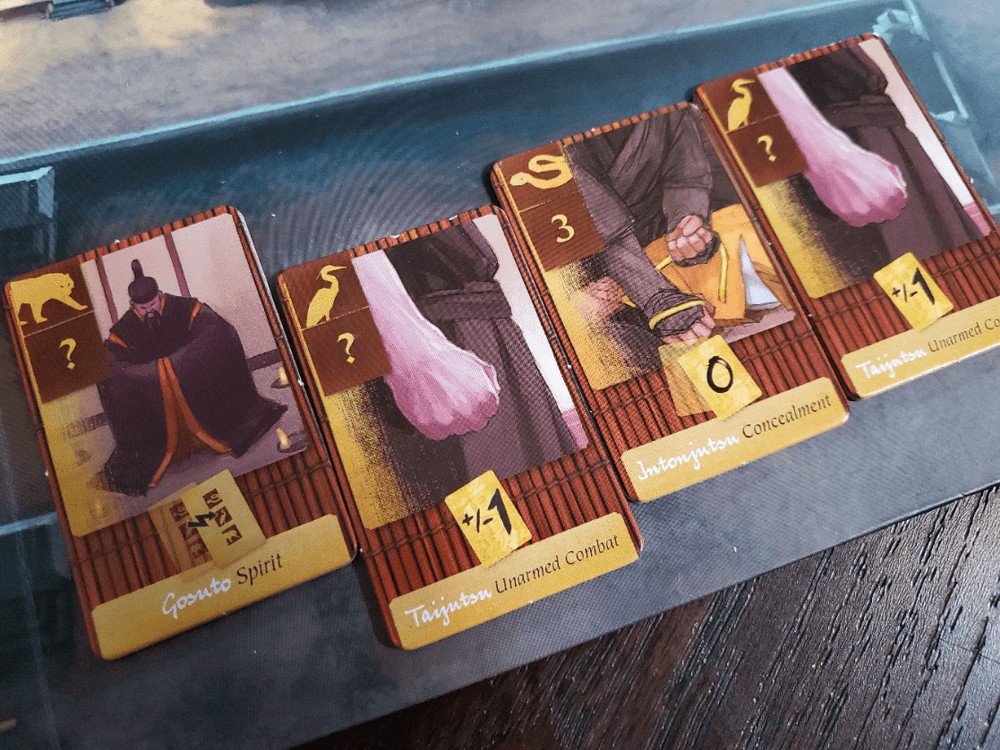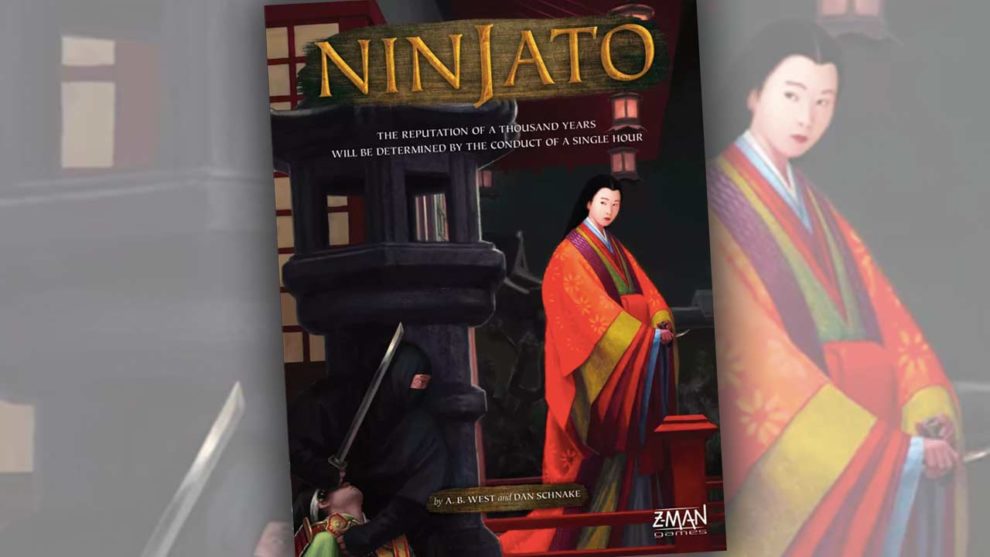“Perhaps the final ninja trick was leaving little trace for any of us.”
So ends the Historical Notes section at the back of the rulebook for Ninjato, a two-page dive into the Heian Period and the Japanese legend of the Shinobi upon which the game is based. Players become master ninja, raiding clan-controlled houses for treasure, bribing envoys, and spreading rumors to gain honor and become the Ninjato, the invisible sword of the ruling family.
Ninjato is no spring chicken, a 2011 release from Z-Man Games and the mind of Adam West (Transmissions, Wizards of the Wild). As a game, it lurks in the shadows, an agent of the night that leaves its indelible mark while, sadly, never drawing an excess of attention. But there is a lot to get excited about in a subdued, ninja sort of way.
Banzai!
The game board is an 11th-century village, or thereabouts, with a handful of locations to choose from. Players use their shuriken as “workers” to make selections across seven rounds, each with three turns.

The bulk of Ninjato’s intrigue revolves around raiding the five clan houses. Each house is marked with a clan token and contains a number of treasures guarded by a numbered sentry card. The clan house is a push-your-luck endeavor. Based on the value of the visible sentry, players choose to attack either by strength (playing a higher number) or by stealth (a lower number) using a single card from their hand plus any available kicker cards. Cards range from 1-5 with the three doubling as a modifying kicker worth ±1.
A defeated guard yields one house treasure—from lowest value to highest—and the choice to either continue in the same vein (by strength or by stealth) or leave with the accumulated treasure. The desire to continue must be communicated by a hearty cry of Banzai!! Should every guard fall, the player also then exchanges the house’s clan token for one from another clan. Should the player lose at any point (ties are losses), they take one treasure as compensation, discard the rest and leave the house in shame, but only after adding one more treasure.

Mixed throughout the guard cards are Alarm guards that both add treasure to the house and cause the most valuable treasures to be defended by elite guards. Some elites boast more challenging values. Others count as two separate guards that must both be defeated, but defeated elites are kept for honor points at the end of the game.
Cards are always discarded as they are played, forcing players to visit the Dojo for more—ideally suiting them for either strength or stealth raids—repeatedly throughout the game. Players visit the Sensei to purchase skills for their invasions: additional modifiers, stronger card values, or maybe the ability to switch attack styles mid-turn. The Palace is the place for bribing Envoys from each of the clans, acquiring cards representative of influential figures. The Pavilion is where Rumors are born, cards that feed endgame scoring by rewarding the acquisition of various cards and tokens during play.
Banzai!!
Ninjato’s strategy clicks into place during three interim scoring stops. The clan tokens marking each of the houses hold a point value. During interim scoring, the player holding the most Envoy cards for each of the three clans chooses between claiming points equal to the total value of those clan tokens or a free Rumor card. The player with the second most Envoy cards receives what was left behind. All of a sudden reaching those clan tokens during a raid takes on another layer of importance. Defeating a house at the right time to get the right token in place to match your own acquired Envoys is critical.
Treasures, which are used to bribe the Envoys and collect Rumors, score honor points when they are spent, adding another wrinkle to the mix. Invading the right house for the best resources to gain the needed Envoys (each features an age that serves as a tie-breaker during scoring) and the Rumors that best complement scoring and strategic pursuits while controlling those clan tokens [takes a deep breath]; let’s just say the mechanics are slightly entangled.

Following the seventh-round scoring, the Rumors take over for the end game. Most are treated as multipliers: collect one to score a point for each Envoy card, for example; collect two for two points each or three for four points each. Another Rumor type has its value determined by the number of players who gained that card type during the game, with exclusivity equalling massive points. Rumors can easily account for more than a third of a player’s score, so they cannot be ignored. Unspent treasures and defeated red guards add a pittance before the declaration of a victor.
BANZAI!!!
Twenty-one turns might sound like a lot, but there are no junk spaces on the board and there is no time to waste in Ninjato’s economy. Perhaps in the first round you acquire a skill from the Sensei, then raid, spending the rest of your cards, and then visit the Dojo to replenish your hand, but that’s it. You still need to hit up the Palace and Pavilion early and often, and you need treasure to pull it all together before the first interim score after round three. Which brings us back to the raids…
It is this equation that makes the push-your-luck inside every clan house so much fun. The game elicits an inherent desire to finish every battle, or at least to enter every battle with enough cards (more than you have time to gain) so as to have a chance at swapping a clan token. But there is just enough randomness in the revelation of the guard deck to make perfect planning impossible. You never walk away empty-handed, but three treasures are greater than one every time. Failure may add another treasure to the house and another guard to be defeated, but you never want to set the stage for another ninja to finish what you started—especially with a clan token on the line.

There is no doubt the ninja are more enjoyable with the higher player counts. There’s something about jockeying for clan position that gets more interesting with more participants. In addition, the fact that the Envoy and Rumor cards do not reset until the end of a round takes on great tension at four players. The cards just don’t disappear as quickly with two at the table. In fact, we often implement a single card rotation/discard each round when we play with two just to keep the market fresh. There is a risk of stagnation if the Rumors don’t match either player’s strategy or if the Envoys are heavily loaded to a less desirable clan. I recommend four, then three, then two players, but Ninjato holds up pretty well at every count.
The Sensei tiles are interesting. Being able to add or subtract two with a Dojo card, or immediately convert a card to a six or a zero is wonderfully useful. What I love about these tiles is that you can win without them. But should you approach them, there are also Rumor cards in the mix that reward the effort, creating a lovely side avenue of scoring to match your deft abilities. Chasing the tiles might mean fewer raids, but more effective raids. It seems every strategic option has a complement somewhere in the box to make it worthwhile. In the last three rounds, only a single tile is made available, a mask that can count as an extra Envoy to steal away a clan bonus—a hot commodity to say the least.

We don’t bring out Ninjato all that frequently, but I’m impressed every time we do. I immediately want to play again. The mechanics are immersive, and the artwork is a wonderful match. The box cover is fantastic with a ninja crouched over an unconscious sentry while an Envoy stands in alarm, her knife drawn. Darkness and the light. Shadows and color. I love the realism on the cards and the layout of the game board. The treasure icons stand out as overly cartoonish, but I can’t really complain. The wooden shuriken stars are absurdly oversized, but I’m a big fan of that decision. They occasionally get in the way around the clan houses, but with all these ninja about, you can’t expect elbow room.
The back of the rulebook, as I mentioned earlier, contains a brief history of 9th-12th century Japan to paint a portrait of the game’s setting. The emblems (Mon) on the clan tokens are authentic—an indicator of the level of care in the design. Beyond even that, the final two pages talk about Heian party games involving poetry, just in case you wanted to try your hand at metrical 5-7-5-7-7 battles where the lower couplet builds upon or rebuts the upper phrase. I welcome the stuff of ancient game nights! I think it’s wonderful when a publication team goes the extra mile.
They’ve included a few design notes as well. Ninjato was born of a season that included reading Souyri and Roth’s The World Turned Upside Down and playing games like Stone Age, Incan Gold, and The Princes of Florence. Any game that makes me want to know more about where it came from scores a few bonus points in my sight. Plus, if these titles were inspirations, then I have a few more titles to seek out or dust off while I’m in the Ninjato mood.
The rest of the rulebook is quite thorough for learning purposes, and the variety of inset notes, illustrations, and extended examples serve as worthy mid-game references.
Ninjato was reimplemented in 2019 by WizKids as a card game called Kodachi. Check out our review of Kodachi for an introduction and a few words comparing the titles. As for the original, though, the ninja aren’t as easy to come by these days apart from the used game market. But if you manage to acquire a copy, you’re in for a clever and thoroughly designed treat.












Add Comment